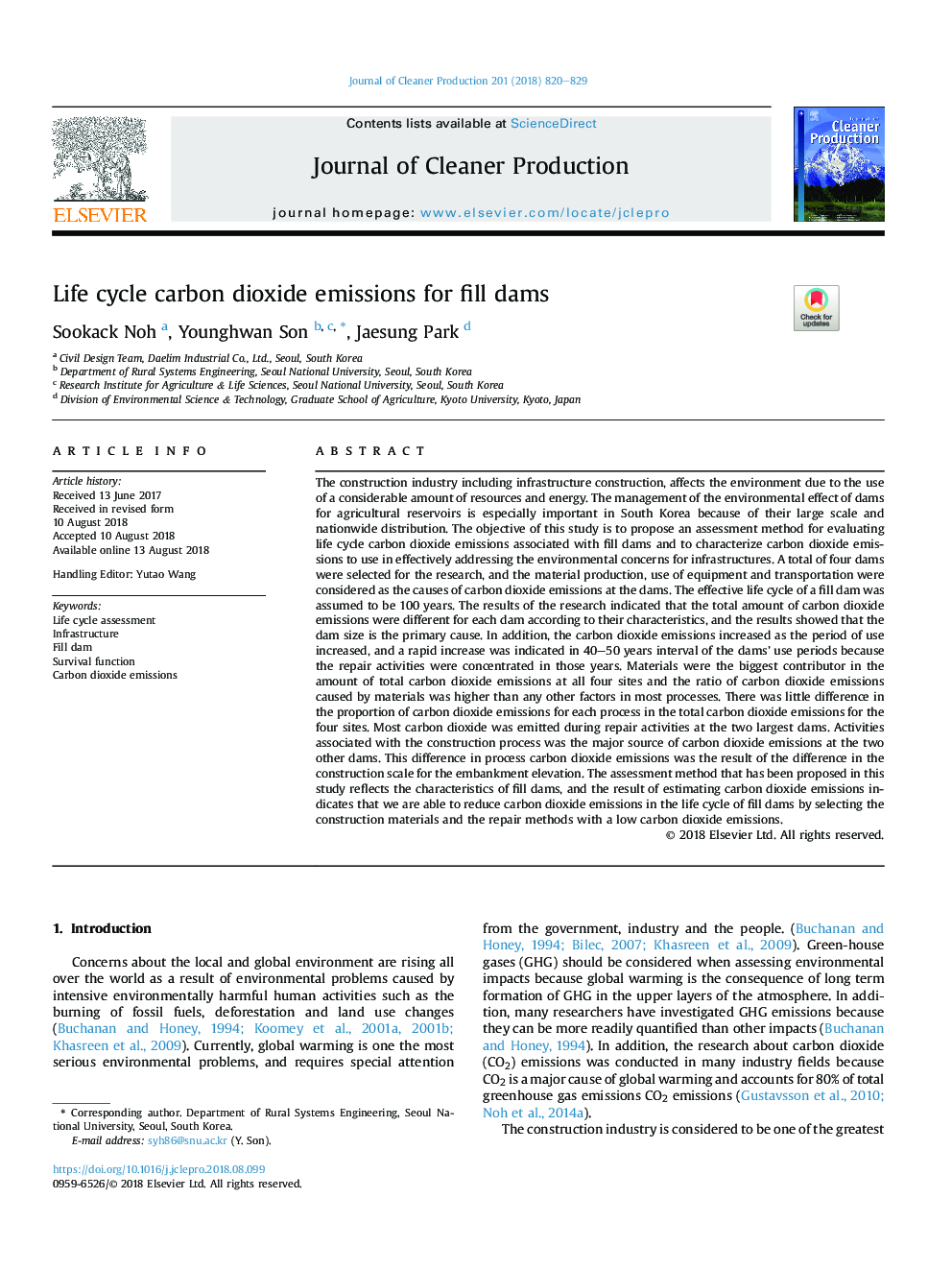| کد مقاله | کد نشریه | سال انتشار | مقاله انگلیسی | نسخه تمام متن |
|---|---|---|---|---|
| 8092879 | 1522051 | 2018 | 10 صفحه PDF | دانلود رایگان |
عنوان انگلیسی مقاله ISI
Life cycle carbon dioxide emissions for fill dams
ترجمه فارسی عنوان
سیکل زندگی دی اکسید کربن برای پر کردن سدها
دانلود مقاله + سفارش ترجمه
دانلود مقاله ISI انگلیسی
رایگان برای ایرانیان
کلمات کلیدی
ارزیابی چرخه حیات، زیر ساخت، سد را پر کنید عملکرد بقا، انتشار دی اکسید کربن،
ترجمه چکیده
صنعت ساخت و ساز از جمله ساخت و ساز زیر ساخت، به دلیل استفاده از مقدار قابل توجهی از منابع و انرژی، محیط را تحت تاثیر قرار می دهد. مدیریت اثرات زیست محیطی سدها برای مخازن کشاورزی به دلیل گستردگی و توزیع در سراسر کشور به ویژه در کره جنوبی بسیار مهم است. هدف از این مطالعه ارائه یک روش ارزیابی برای ارزیابی انتشار دی اکسید کربن در ارتباط با سدهای پر شده و توصیف انتشار دی اکسید کربن است که به طور موثر در زمینه نگرانی های زیست محیطی برای زیرساخت ها مورد استفاده قرار می گیرد. در مجموع، چهار سد برای تحقیق انتخاب شدند و تولید مواد، استفاده از تجهیزات و حمل و نقل به عنوان علت انتشار دی اکسید کربن در سدها مورد توجه قرار گرفت. چرخه زندگی موثر سد پر از 100 سال بود. نتایج حاصل از این تحقیق نشان می دهد که میزان کل انتشار دی اکسید کربن برای هر سد با توجه به ویژگی های آن متفاوت است و نتایج نشان داد که اندازه سد علت اصلی آن است. علاوه بر این، میزان انتشار دی اکسید کربن به عنوان دوره استفاده افزایش یافته و افزایش سریع در فاصله 40-50 سال دوره استفاده از سدها به دلیل فعالیت های تعمیر در آن سال ها متمرکز شده است. مواد بیشترین میزان انتشار دی اکسید کربن در هر چهار سایت را داشتند و نسبت انتشار دی اکسید کربن ناشی از مواد بالاتر از سایر عوامل در اکثر فرایندها بود. در مقایسه با میزان انتشار دی اکسید کربن برای هر فرایند در مجموع انتشار دی اکسید کربن برای چهار سایت، تفاوت کمی وجود دارد. اکثر دی اکسید کربن در طول فعالیت های تعمیر و نگهداری در دو بزرگترین سد منتشر شد. فعالیت های مرتبط با روند ساخت و ساز منبع اصلی انتشار دی اکسید کربن در دو سد دیگر بود. این تفاوت در فرایند انتشار دی اکسید کربن ناشی از تفاوت در مقیاس ساخت و ساز برای ارتفاع کف زمین است. روش ارزیابی که در این مطالعه پیشنهاد شده است، ویژگی های سد های پر شده را نشان می دهد و نتیجه برآورد انتشار دی اکسید کربن نشان می دهد که ما می توانیم با انتخاب مصالح ساختمانی و تعمیرات ما کاهش انتشار دی اکسید کربن در دوره زندگی سدها را پر کنیم. روش های با انتشار دی اکسید کربن کم.
موضوعات مرتبط
مهندسی و علوم پایه
مهندسی انرژی
انرژی های تجدید پذیر، توسعه پایدار و محیط زیست
چکیده انگلیسی
The construction industry including infrastructure construction, affects the environment due to the use of a considerable amount of resources and energy. The management of the environmental effect of dams for agricultural reservoirs is especially important in South Korea because of their large scale and nationwide distribution. The objective of this study is to propose an assessment method for evaluating life cycle carbon dioxide emissions associated with fill dams and to characterize carbon dioxide emissions to use in effectively addressing the environmental concerns for infrastructures. A total of four dams were selected for the research, and the material production, use of equipment and transportation were considered as the causes of carbon dioxide emissions at the dams. The effective life cycle of a fill dam was assumed to be 100 years. The results of the research indicated that the total amount of carbon dioxide emissions were different for each dam according to their characteristics, and the results showed that the dam size is the primary cause. In addition, the carbon dioxide emissions increased as the period of use increased, and a rapid increase was indicated in 40-50 years interval of the dams' use periods because the repair activities were concentrated in those years. Materials were the biggest contributor in the amount of total carbon dioxide emissions at all four sites and the ratio of carbon dioxide emissions caused by materials was higher than any other factors in most processes. There was little difference in the proportion of carbon dioxide emissions for each process in the total carbon dioxide emissions for the four sites. Most carbon dioxide was emitted during repair activities at the two largest dams. Activities associated with the construction process was the major source of carbon dioxide emissions at the two other dams. This difference in process carbon dioxide emissions was the result of the difference in the construction scale for the embankment elevation. The assessment method that has been proposed in this study reflects the characteristics of fill dams, and the result of estimating carbon dioxide emissions indicates that we are able to reduce carbon dioxide emissions in the life cycle of fill dams by selecting the construction materials and the repair methods with a low carbon dioxide emissions.
ناشر
Database: Elsevier - ScienceDirect (ساینس دایرکت)
Journal: Journal of Cleaner Production - Volume 201, 10 November 2018, Pages 820-829
Journal: Journal of Cleaner Production - Volume 201, 10 November 2018, Pages 820-829
نویسندگان
Sookack Noh, Younghwan Son, Jaesung Park,
